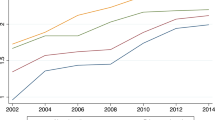Abstract
The paper discusses the problems of measuring the rate of return to women's education, and evidence is presented for nine countries which shows that the returns to secondary and higher education are on average two percentage points lower for women than for men, but in some countries they are actually higher. Education increases the earning capacity of women, and also increases their propensity to remain in the labour market. But some allowance must be made for the value of women's non-market work, for indirect benefits of education, and for psychic income. Various methods are suggested for measuring the non-monetary benefits of education, such as the intergeneration effect of a mother's education on the future achievement of her children, or the non-pecuniary benefits of employment for women in the labour force. The effects of discrimination on women's earnings and job prospects are discussed, and it is shown that a large part of the observed differential between male and female earnings is due to the concentration of women in low-income occupations. The paper concludes that the difference between the returns to education for men and women is less than is often suggested, particularly if some attempt is made to measure nonmonetary benefits. But the returns to women's education would be increased if there were a change in traditional attitudes leading to a more equal occupational distribution and better utilisation of women in the labour force.
Similar content being viewed by others
References
Arregger, C. E. (1966). Graduate Women at Work. Newcastle upon Tyne: Oriel Press.
Becker, G. (1957). The Economics of Discrimination. Chicago: University of Chicago Press.
Becker, G. (1964). Human Capital: A Theoretical and Empirical Analysis. New York: Columbia University Press.
Blaug, M. (1970). An Introduction to the Economics of Education. London: Allen Lane, The Penguin Press.
Blaug, M. (1972). “atThe Correlation between Education and Earnings: What Does it Signify?” Higher Education (February).
Bowen, W. G., and Finegan, T. A. (1969). The Economics of Labor Force Participation. Princeton, New Jersey: Princeton University Press.
Boynton, J., and McKenna, E. E. (1965). “atSome Factors Associated with Age-grade Placement of Migrant Children,” Rural Sociology.
Brazer, H. E., and David, M. (1962). “Social and Economic Determinants of the Demand for Education,” in S. Mushkin, Economics of Higher Education. U.S. Office of Education.
Cain, G. (1966). Married Women in the Labour Force: An Economic Analysis. Chicago: Chicago University Press.
Clark, C. (1958). “The Economics of Housework,” Bulletin of the Oxford Institute of Statistics (May).
Cohen, M. S. (1971). “atSex Differences in Compensation,” Journal of Human Resources (Fall).
Department of Education and Science (1971). Survey of Earnings of Qualified Manpower in England and Wales 1966–67. Statistics of Education, Special Series No. 3. London: H.M.S.O.
Dodge, N. T. (1966). Women in the Soviet Economy. Baltimore: John Hopkins Press.
Dugan, D. J. (1969). “The Impact of Parental and Educational Investments upon Student Achievement,” mimeo paper presented to the American Statistical Association.
Fogarty, M. P. et al. (1971a). Sex, Career and Family. London: George Allen and Unwin, for P.E.P.
Fogarty, M. P. et al. (1971b). Women in Top Jobs. London: George Allen and Unwin, for P.E.P.
Gwartney, J. D. (1972). “atDiscrimination, Achievement, and Pay-Offs of a College Degree,” Journal of Human Resources (Winter).
Gwartney, J., and Stroup, R. (1971). “Sex Discrimination in Employment: The Man or the Myth?” mimeo paper presented to Western Economic Association.
Hines, F., et al. (1970). “Social and Private Rates of Return to Investment in Schooling by Sex Groups and Regions,” Journal of Human Resources (Summer).
Hunt, A. (1968). A Survey of Women's Employment. London: H.M.S.O.
Kreps, J. (1971). Sex in the Market Place: American Women at Work. Baltimore: John Hopkins Press.
McNulty, D. J. (1967). “Differences in Pay Between Men and Women Workers,” Monthly Labor Review (December).
Mincer, J. (1962a). “On-the-Job Training: Costs, Returns and Some Implications,” Journal of Political Economy Supplement (October).
Mincer, J. (1962b). “Labour Force Participation of Married Women: A Study of Labour Supply,” in Aspects of Labor Economics. Princeton: Princeton University Press.
Moreh, J. (1971). “Human Capital and Economic Growth: United Kingdom, 1951–1961,” Economic and Social Review (October).
Morris, V., and Ziderman, A. (1971). “The Economic Return on Investment in Higher Education in England and Wales,” Economic Trends (May).
O.E.C.D. (1971). Educational Expansion in OECD Countries since 1950. Paris: O.E.C.D.
Oppenheimer, V. K. (1970). The Female Labor Force in the U.S.: Demographic and Economic Factors Governing its Growth and Changing Composition. Berkeley: Institute of International Studies.
Ostry, S. (1968). The Female Worker in Canada 1968. Ottawa: Dominion Bureau of Statistics.
Psacharopoulos, G. (1973). Returns to Education: An International Comparison. Amsterdam: Elsevier.
Royal Commission on the Status of Women in Canada (1970). Report. Ottawa: Information Canada.
Sanborn, H. (1964). “Pay Differences between Men and Women,” Industrial & Labor Relations Review (July).
Schultz, T. (1970). “The Reckoning of Education as Human Capital,” in Education, Income & Human Capital, ed. Lee Hansen. New York: Colombia University Press.
Seear, B. N. (1971). Re-Entry of Women to the Labour Market after an Interruption in Employment. OECD.
Siegel, P. M. (1965). “On the Cost of Being a Negro,” Sociological Inquiry (Winter)
Sirageldin, I. H. (1969). Non-Market Components of National Income. Ann Arbor: University of Michigan Survey Research Center.
Swift, W. J., and Weisbrod, B. A. (1965). “On the Monetary Value of Education's Intergeneration Effects,” Journal of Political Economy (December).
Thias, H., and Carnoy, M. (1969). Cost-Benefit Analysis in Education: A Case-Study on Kenya. World Bank Report No. EC-173.
Weisbrod, B. A. (1964). External Benefits of Public Education: An Economic Analysis. Princeton, N. J.: Princeton University Press.
Women's Bureau (1969). Handbook of Women Workers, 1969. U.S. Department of Labor: Women's Bureau Bulletin 294. Washington: U.S. Government Printing Office.
Author information
Authors and Affiliations
Rights and permissions
About this article
Cite this article
Woodhall, M. The economic returns to investment in women's education. High Educ 2, 275–299 (1973). https://doi.org/10.1007/BF00138806
Issue Date:
DOI: https://doi.org/10.1007/BF00138806




